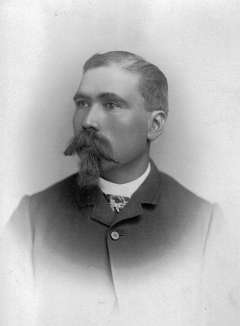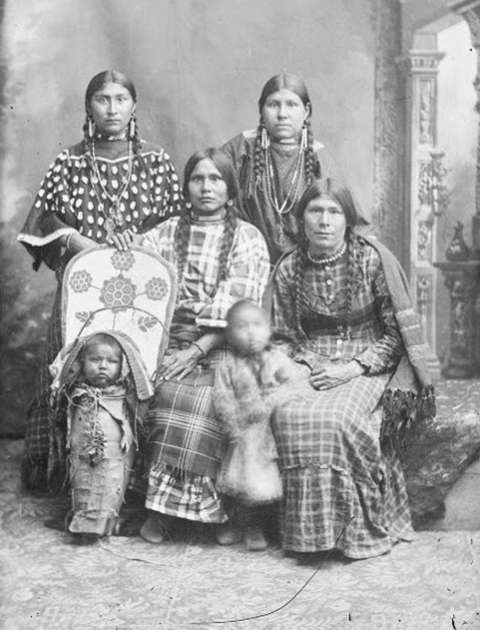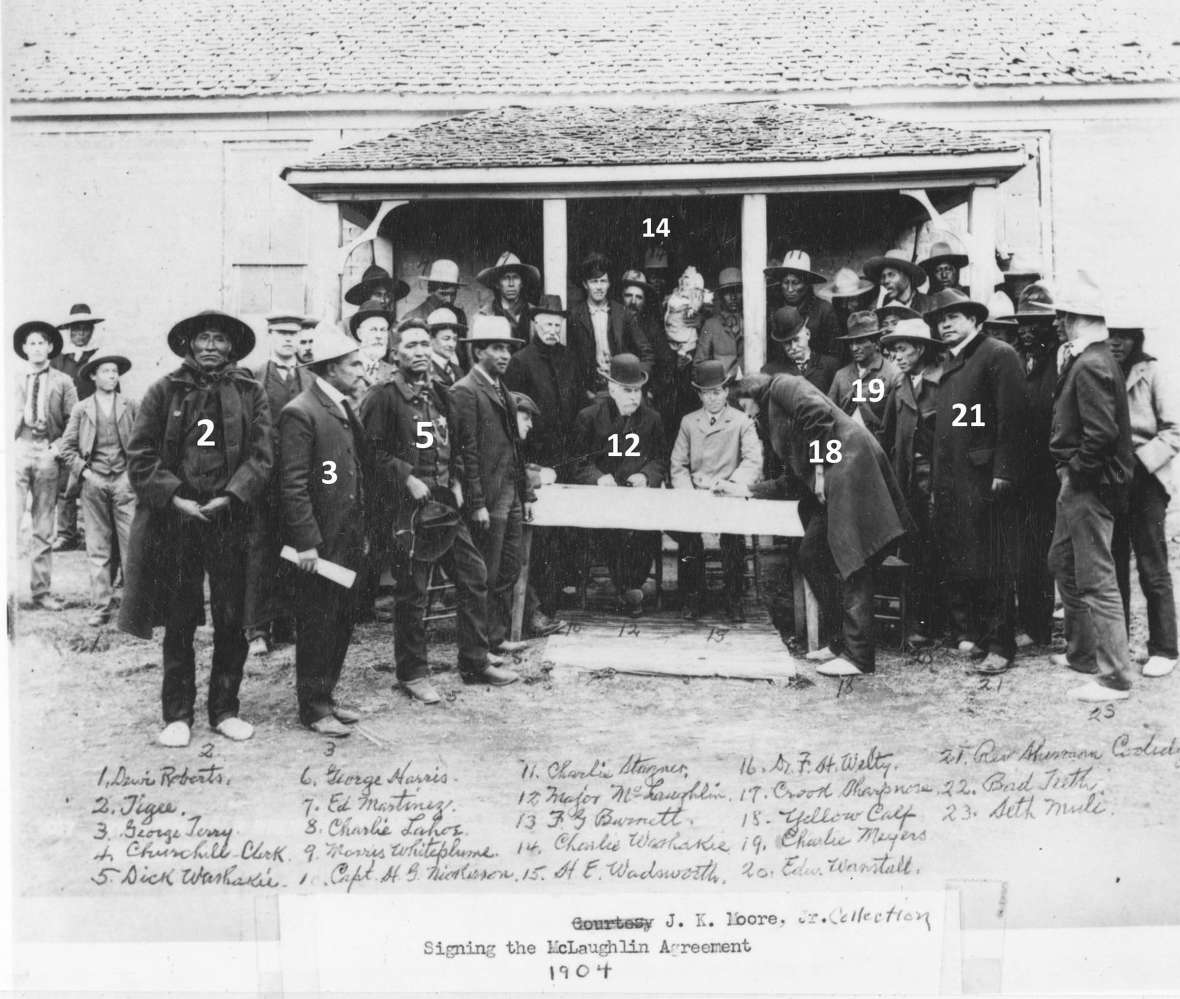- Home
- Encyclopedia
- Three Photos, a Murder and a Murky Outcome: Tro...
Three Photos, a Murder and a Murky Outcome: Troubled Times on Wind River
While investigating a recent visitor’s question, staff at the Sweetwater County Historical Museum in Green River, Wyo. came across an old, striking photograph. Its subject is a somber young Native American woman gazing directly at the camera. It is difficult to shift your gaze away from her eyes. She is wearing a dress adorned with ivory elk tusks, the mark of a prosperous Plains tribe family that included at least one very able hunter.

She also appears in another photo, still on exhibit in the museum’s gallery, with three other Native American women and two children. It is this photo that initially captured the visitor’s interest and prompted a special research project into the women’s identities.
Museum staff identified the girl in the elk-ivory dress as Kate Enos. Thanks to Robyn Rofkar of the Eastern Shoshone Cultural Center in Fort Washakie, Wyo., a collateral descendant of Kate’s, we now know the three women are her sisters, Louisa Enos Wesaw, Mary Enos Rabbittail and Emma Enos Lewis. The baby in the cradle board, believed to be Antoine Weed, and the little girl standing, Sousanna Weed, are Mary Enos Rabbittail’s children. There are stories behind all photographs that have survived from the frontier era, though many of them are forever lost to time. Kate’s story did not turn out to be a happy one.
She and her sisters were mixed-blood Shoshones; Kate was born near Fort Bridger, Utah Territory in 1862. In 1885 she married George Terry, the son of a Mormon bishop and Anne Greasewood, a Shoshone woman. Though they had seven children together—only one of which survived into adulthood—the marriage was troubled. At least once, Kate went to what’s now the Wind River Reservation in Fremont County, at the time still known as the Shoshone Reservation, to live with her father, John Enos, and was unwilling to return home. Reportedly, George forced her back.
Later, on the reservation, George Terry was active in the Eastern Shoshone Council of Chiefs and tribal politics. He was not popular and made enemies, as he was known to be in favor of selling tribal lands. In 1904, sufficient members of the Eastern Shoshone and Northern Arapaho tribes signed an agreement with the U.S. government giving up more than half the reservation for white settlement. But while a strong majority of Shoshones voted to approve the agreement, only a small minority of Arapahos did. The government, however, had refused to negotiate separately with the tribes; George Terry spoke eloquently in favor of the proposal. Most of the 1.4 million acres the tribes gave up had been unoccupied grazing land or had been occupied by Arapahos.

The ceded lands were opened to white settlement in 1906, and soon, lawlessness, most of it whiskey-based, increased around the edges of the reservation. At the same time a new strain of vigilantism arose. Tribal members who had favored the land cessions received threats.
In December 1906, George Terry’s barn and two haystacks were burned. Five horses died in the fire. In January 1907, on the eve of a trip to Washington, D.C., where he would represent Eastern Shoshone grievances over lack of payment for the ceded lands, he was murdered. On January 11, the Wind River Mountaineer reported that:
“George Terry, well known as a member of the Shoshone council, living at the Agency, was murdered last night about eight o’clock, while going from the store to his home but a short distance away. His body was found between the store and the office and he had been struck in the back of the head with a club, or some similar instrument, from the effects of which he died in a few minutes. When found he had an unopened knife in his hand, as though he had drawn it in self defense, but had had no chance to use it before he was struck down.”
George Terry was a Mormon elder; after his death “rumors” circulated, according to the Wind River Mountaineer, “that a letter was found on his body from one of the leading elders of the Mormon church at Salt Lake City, stating that the lights he, Terry, had been seeing in the heavens was his daughter who was trying to warn him of immediate danger.” Before the end of January, Terry’s remains were accompanied to Salt Lake City for burial by Kate and their daughter.
Local efforts to solve the crime were unsuccessful. In April, a special agent sent from Washington by the Bureau of Indian Affairs came to Wind River and obtained a confession from John McAdams, whose brother, Jim McAdams, was said to be in a relationship with Kate Enos. John McAdams told authorities that he, Baptiste Enos, George Enos and Charles Myers (or Meyers) were responsible. (Baptiste Enos, also known as “Bat,” was Kate’s nephew, and George Enos was her brother.)
John McAdams said that Terry was beaten with an iron bar. Baptiste, George and Charles Myers were arrested. Jim McAdams and Kate were also jailed, though both denied any involvement in Terry’s death and John McAdams also declared that they had nothing to do with it.
With strong alibis, McAdams’s alleged co-conspirators were immediately released, but his brother and Kate remained in custody. Later in April, John McAdams recanted his confession. A month later, he was transferred to Cheyenne to await trial in federal court, while Jim McAdams and Kate Enos were released.
With her husband in the Laramie County Jail, John McAdams’s wife, Ellen, came forward with an alibi claiming to the Cheyenne Daily Leader, “if her husband said he killed Terry he was certainly crazy at the time.” Still, McAdams had to wait for the court to convene in November. After six months of incarceration, in the absence of any additional evidence, a grand jury returned a “no bill” and he was released. No additional charges were ever filed, and the case remains officially unsolved.

In the annual tribal census for 1906 and 1907, Kate was listed as Katie Terry McAdam, married to James McAdam [McAdams]. The following year, on July 29, 1908, Kate died and was buried the following day.
It seems clear that there was a mixture of motives behind George Terry’s murder. In addition to a flawed marriage and bad blood, maltreatment of Native Americans on the Shoshone Reservation on an appalling scale was also a factor. Much of the bitterness was grounded in the Dawes Act, signed into law by President Grover Cleveland in 1887. The Dawes Act permitted the federal government to break apart established communal tribal lands by partitioning them off into individual, privately-owned parcels of 40 to 160 acres. Its goal was to compel assimilation of Native Americans, including both the Eastern Shoshone and the Northern Arapaho who were, by that time, an established presence on the Shoshone Reservation, into mainstream U.S. society and repress their social and cultural traditions.
In 1896, for instance, the tribes sold the hot springs at what is now Thermopolis, Wyo., to the federal government for $60,000. But that was little compared to what happened in 1904-1905, when James McLaughlin, the Indian agent who negotiated the hot springs deal, convinced the tribes to cede 1.4 million acres of reservation land north of the Big Wind River under very complex and lopsided terms involving townsite, homestead and mineral laws pending sale of those lands rather than outright payment.
The third photo
As a Shoshone leader, George Terry signed and advocated for the agreement. He is one of a group of men in an eerie photograph of the signing ceremony. Also present at the signing and in the photo is Charles Meyers, one of his alleged killers, as identified by John McAdams. When asked for a motive, McAdams’s confession did not cite Kate’s mistreatment. Instead, McAdams “stated that Terry was not liked […] on account of his domineering ways and because of the fact that he had worked so hard for the opening of the reservation.”
In the week after Terry’s murder, the Rev. John Roberts, who also favored the McLaughlin 1905 agreement, feared for his life and required troops to escort him and his family from Lander, Wyo. to Fort Washakie. George Terry’s murder prevented him from representing the Shoshones’ point of view concerning the 1.4-million-acres land session in Washington, D.C. Before Terry’s death, the four-person delegation was described by The Lander Clipper as “a representative one and will be able to give the authorities at Washington a clear statement of their grievances.” By 1907, the Shoshone and Arapaho had yet to see any payment for the land they signed away two years earlier.
That somber image of Kate, held in the Sweetwater County Museum collections, captures our gaze, telling us more than just the story of a hard marriage and slain husband. For her husband’s murder Kate maintained her innocence, and in his confession—later renounced—John McAdams affirmed it. To believe McAdams may have done it is appealing, but we can never really know for certain. It is certain that Terry’s murder wasn’t just a family dispute: It struck at the heart of reservation politics. Even Wyoming’s U.S. congressman, Frank Mondell, used Terry’s murder to request troops remain at Fort Washakie, which had been ordered to be abandoned that year. Fort Washakie remained occupied by U.S. troops for another three years.
In 1934, some 50 years after its passage, the Dawes Act was repealed, but the harm had long since been done. Nationwide, of about 138 million acres of tribal lands, only about 48 million remained in tribal possession.
Kate Enos’s life was tragic, but it was only a small part of a much greater tragedy: the mistreatment of this country’s Native Americans and the bitter conflicts it created.

Editors’ note: This article was funded in part by Rocky Mountain Conservancy, a nonprofit Cooperating Association based in Estes Park, Colo., through book store sales at the National Historic Trails Interpretive Center in Casper, Wyo. We offer our special thanks.
Resources
Primary Sources
- Newspapers from Wyoming Newspaper Project, accessed Oct. 16, 2022:
- "Shoshone Grievances,” The Lander Clipper, Vol. 20, No. 18, January 4, 1907
- “George Terry Murdered,” Wind River Mountaineer, Vol. 23, No. 7, January 11, 1907
- “Murder on Reserve,” The Lander Clipper, Vol. 20, No. 19, January 11, 1907
- “Fear Indians,” Wyoming Tribune, Vol. 13, No. 15, January 16, 1907
- “Actions of Indians Cause Uneasiness,” and “Terry’s Body Shipped to Salt Lake City,” Wind River Mountaineer, Volume 23, Number 8, January 18, 1907
- “Attempt Murder,” The Lander Clipper, Vol. 20, No. 20, January 18, 1907
- “Led a Romantic Life,” and “Fear Indians,” Wyoming Tribune Vol. 13, No. 15, January 16, 1907
- “Mondell Protests,” Wyoming Tribune, Vol. 13, No. 21, January 23, 1907
- “Troops to Remain at Ft Washakie,” Natrona County Tribune, Vol. 16, No. 36, January 23, 1907
- “McAdams Says He Lied,” Wyoming State Journal and Lander Clipper, Vol. 20, No. 34, April 26, 1907
- “McAdams Bound Over,” The Wyoming State Journal, Vol. 20, No. 35, May 3, 1907
- “Claims She Has an Alibi,” The Cheyenne Daily Leader, Vol. 39, No. 229, May 26, 1907
- “The Evidence is Romantic,” The Cheyenne Daily Leader, Vol. 40, No. 51, November 16, 1907
- Interviews and correspondence with Robyn Rofkar, Eastern Shoshone Cultural Center, Fort Washakie, Wyoming
Secondary Sources
- “Fragmenting Tribal Lands: The Dawes Act of 1887." WyoHistory.org, accessed Oct. 18, 2022 at /encyclopedia/fragmenting-tribal-lands-dawes-act-1887.
- Gardner, A. Dudley. “The Shoshone and the Seeds of Change, 1803-1868.” Western Wyoming Community College, Rock Springs, Wyo., 2011.
- Hilton-Hagemann, Brandi Lynn. “Indigenous Nationalism on the Wind River Indian Reservation, 1851-1938." Doctoral dissertation, University of Oklahoma, 2013, accessed Oct. 18, 2022 at https://shareok.org/bitstream/handle/11244/319524/HiltonHagemann_ou_0169D_11021.pdf?sequence=1&isAllowed=y.
- Lewandowski, Tadeusz. “Sherman Coolidge: Arapaho Priest in a Changing World.” WyoHistory.org, accessed Oct. 18, 2022 at /encyclopedia/sherman-coolidge-arapaho-priest-changing-world.
- “The Tribes Sell Off More Land: The 1905 Agreement.” WyoHistory.org, accessed Oct. 18, 2022 at /encyclopedia/tribes-sell-more-land-1905-agreement.
Illustrations
- The photos of Kate Enos, her sisters, niece and nephew, and the photo of the signing of the McLaughlin agreement are from the collections of the Sweetwater County Historical Museum, with originals at the American Heritage Center at the University of Wyoming. Used with permission and thanks.
- The photo of George Terry is from ancestry.com. Used with thanks.
